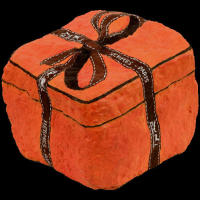
Stephane Jaspert picks the cobblestone up from his desk and says, “Tourists often see Paris as a light and romantic city, but it’s a tough city, hard as rock.”
We are high above the cobbled streets of Montmartre in Jaspert’s garret. The cobblestone he’s holding is the medium for his latest work of art. On it he is painting in high precision a reproduction of the screen of an iPad. He calls it his “iPav,” pavé being French for cobblestone or paving stone.
An artist working in a garret in Montmartre sounds like a cliché—one sold by hilltop street artists drawing portraits and selling colorful Paris scenes. But here and there men and women still toil away seriously at their art in garrets and larger studios. Looking toward the upper floors as you walk around you’ll see their tall northern windows letting in a light that has attracted artists to Montmartre for now 200 years.
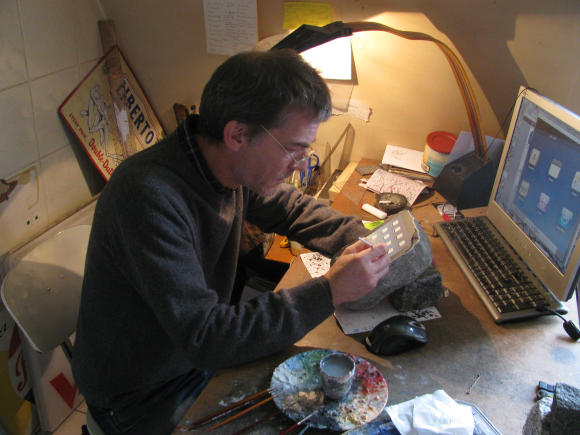
Painting with gouache (tempera) that is finally fixed with an oil varnish spray, Jaspert reproduces more or less well-known images of enormous variety: paintings, sculptures, monuments, logos, icons, personalities, objects, packaging and products.
An affection for any one of these pieces—each is unique—invariably depends in part on the viewer’s personal connection with the image reproduced. Nevertheless, at its best, Mr. Jaspert’s work creates its own, new reality as it recontextualizes those well-known images onto a medium with its own resonance: an authentic cobblestone from a Paris street.
His more successful pieces, from this viewer’s point of view, play with the contrast between the original or natural medium/texture of the thing or image represented and the medium on which Jaspert has represented it. In those cases the cobblestone becomes imbued with the image while the image espouses the cobblestone.
Among his more straightforward pieces, this die
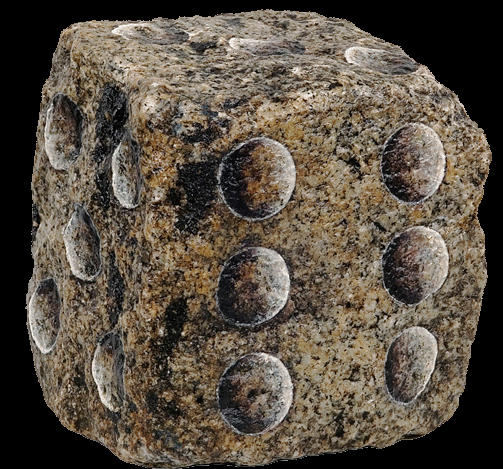
show the precision of his work. Jaspert works from photographs carefully selected to best reveal the colors of the images he’s reproducing. He studied industrial design and his first jobs in the early 1980s were in advertising and computer graphics, both of which have an echo in his cobblestone art.
There’s a good bit of irony in the use of some of the logos and trade dress that he reproduces. Some of them are amusing enough but failed to draw me into the conversation between the corporate intent for the image and the artist’s reuse of those images and trade dress. But in many cases the rendering makes such effective use of the medium’s surface and weight that I willingly lingered, as with this exquisite, 2-kilogram (4.4-pound) Hermes gift box.
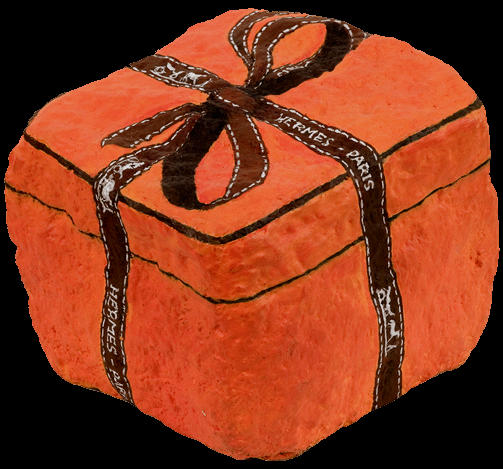
Unlike the examples shown above, most of his work focuses on a single face of the stone, the face that’s been smoothed by years or decades, even more, of life on the street. Even when working with a single face, he uses the contours and texture and dimensions of the stone to full advantage. The mediums give heft in terms of both weight and substance, turning largely two-dimensional work into sculpture, as with the iPav, a fine piece of Flintstonian humor, that he was working on when I arrived, and this slab of ham,

and this chunk of Swiss cheese.
Meanwhile, other pieces carry far more historical or cultural baggage, as in this reproduction of Picasso’s “Guernica.”
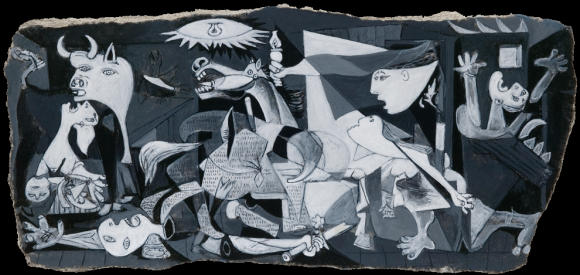
and the wonderful perspective and echo of cobblestones of Caillebotte’s “Paris Street, Rainy Day.”
Jaspert uses the two main types of Paris cobblestones (pavés), which he obtains through contacts in the public works department: a 10x10x10 cm (about 4x4x4 in.) stone called a mosaïque and a 20x15x15 cm (about 8x6x6 in.) stone called an échantillon. A third dimension of cobblestone, a cube measuring 20x20x20 cm (about 8x8x8 in.), called a Napleon, is found in the city far less frequently but nevertheless appears in countless tourist photos since they pave the square in front of Notre-Dame. Most of the stones used in the streets of Paris are granite, along with some sandstone and porphyry. Older paving stones come from Brittany and Normandy but most now come from Portugal.
Because of their relationship with the streets below, Jaspert says, “These stones come loaded with history.”
As does Stephane Jaspert himself. Born in 1961 in Stuttgart to a German father and a French mother, Stephane Jaspert is truly a European post-war product. His French (maternal) grandfather was sent as a prison laborer to work on German farms, where he worked for the German (paternal) grandfather, among others. During the long march of prisoners as the Allies approached, the French grandfather was hidden by the German grandfather. The two men stayed in touch after the war and eventually got together again along with their respective families. The German had a son; the Frenchman had a daughter. Mr. Jaspert is the product of the relationship between that son and that daughter. He grew up in a bilingual household and is also fluent in English.
His reproduction of 17,000 year-old cave paintings from the Hall of Bulls at Lascaux reaches much further back in the mist of continental history. It’s a wonderful work that connects Mr. Jaspert’s interpretation of the icons and images that mark his world with the work of those Paleolithic artists.
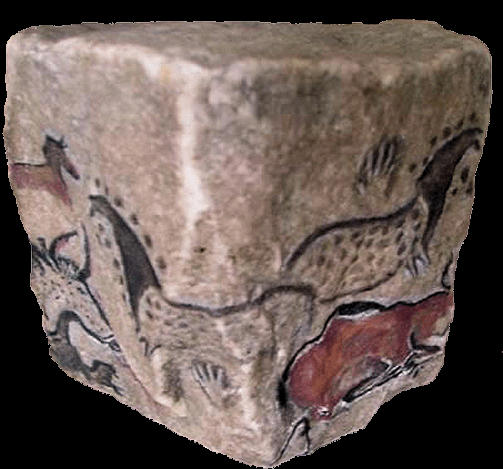
He reaches far and wide in considering iconic images to translate into his work, as in these two échantillons.
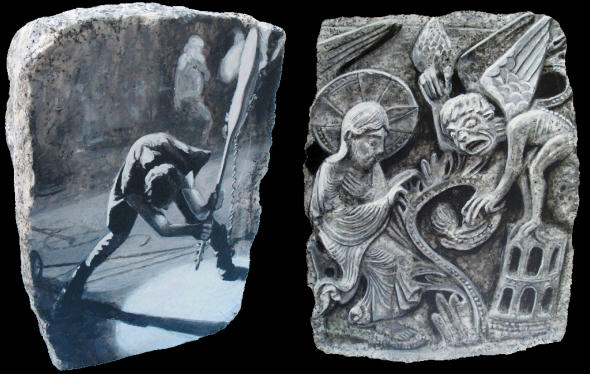
As an artist Jaspert worked on various media in the 1990s—canvas, paper, wood, metal and glass—before hitting upon cobblestones in 1999. He now feels that his work is fully rooted in these stones. “I’m going to do this until my death,” he says, “I’m not going to change anymore.”
Having seen the variety of his work, I don’t believe him.
***
Photos of about 200 of Stephane Jaspert’s cobblestone art painted since 1999 can be found see on the artist’s website. Those interested in purchasing his work may contact Mr. Jaspert through the site to learn about any current exhibitions and gallery representation or for a private showing.
© 2012 Gary Lee Kraut


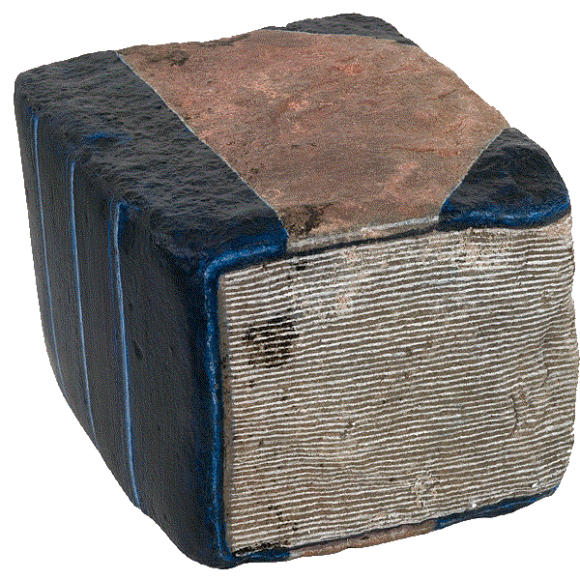
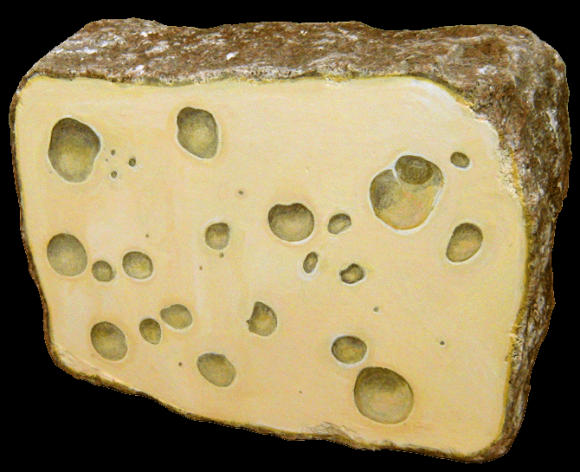
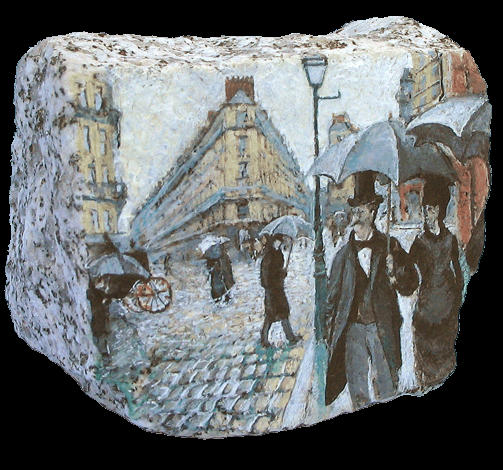
Nice work, both the artist and the article. Interesting how we each find a medium that we feel most in tune with. As an artist myself I’ve worked with various media, including stone, but now mostly work with wood. Would I say “I’m going to do this until my death”? Probably not. So I like the author’s final comment. But I can certainly appreciate Mr. Jaspert’s “feeling” for the stone that he brings out so well in his work. I’m sure that it’s got to be held to be fully appreciated.
Thanks, Pete. The artist may have been joking a little when he said it since he’s got many years of work ahead of him. But I also saw that he has lots of cobblestones in stock, enough to keep him going for a while. Gary
Amazingly beautiful. I wouldn’t leave these paves outside that’s for sure!
Actually, a few are outside on public streets. You can see them here: http://jaspert.free.fr/installation/public_space/
A really Great Job, Amazing, I love it !!